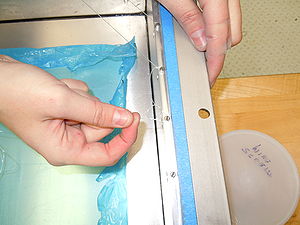Difference between revisions of "MainPage:Nuclear:KaonDetector:Wires"
| Line 11: | Line 11: | ||
== First wires assembly - training purpose == | == First wires assembly - training purpose == | ||
| − | In order to be trained to make the final assembly of the aerogel trays, we did a series of training on how to place the wires that will prevent any eventual fall of aerogel from the tray. The idea will be to use the same principle used in the HMS detector, the wires will be placed just for an emergency case. The aerogel should not touch them in general, since these wires are really thin and can easily scratch the tiles. | + | In order to be trained to make the final assembly of the aerogel trays, we (Jullianna, Arshak, Marco and Hamlet) did a series of training on how to place the wires that will prevent any eventual fall of aerogel from the tray (March 28-29 2013, at JLab). The idea will be to use the same principle used in the HMS detector, the wires will be placed just for an emergency case. The aerogel should not touch them in general, since these wires are really thin and can easily scratch the tiles. |
| − | Our first training was with a thick nylon wire, used for fishing. The first idea was to place | + | Our first training was with a thick nylon wire, used for fishing. It was a good exercise to develop knots to make wires strained, as seen bellow. |
| + | |||
| + | {| border="0" style="text-align:center;" width="100%" | ||
| + | |+'''Thick nylon wires, a first test to develop knots''' | ||
| + | |- | ||
| + | | valign="top"| | ||
| + | [[File:wires_nylon01.jpg|thumb|center|300px|1) Equipment "Perkin/Elmer Lambda 750 Spectrometer" used for the analysis.]] | ||
| + | | valign="top"| | ||
| + | [[File:wires_nylon02.jpg|thumb|center|300px|2) Inside the spectrometer where the monochromatic light beam is chopped in two: reference and beam. The sample to be analyzed is placed in the beam position.]] | ||
| + | |} | ||
| + | |||
| + | Then we moved to the thin stainless steel wires (~150 micro-meters in diameter), spare wires from the HMS Aerogel detector. The first idea was to place wires making diagonals, as shown in figure bellow. But this idea didn't work since our detector is a rectangle, the vertical dimension is greater than the horizontal dimension (more bolts in one dimension than in the other). | ||
| + | |||
| + | The lesson taken from this test is that this wires are a more difficult to make be strained. The usage of small springs would be ideal, but if used in such a way to avoid scratching of tiles. The following pictures shows the results of this test. | ||
| + | |||
| + | {| border="0" style="text-align:center;" width="100%" | ||
| + | |+'''Thin stainless steel wires''' | ||
| + | |- | ||
| + | | valign="top"| | ||
| + | [[File:wires_nylon01.jpg|thumb|center|300px|1) Equipment "Perkin/Elmer Lambda 750 Spectrometer" used for the analysis.]] | ||
| + | | valign="top"| | ||
| + | [[File:wires_nylon02.jpg|thumb|center|300px|2) Inside the spectrometer where the monochromatic light beam is chopped in two: reference and beam. The sample to be analyzed is placed in the beam position.]] | ||
| + | |} | ||
Revision as of 20:57, 2 April 2013
| This page is under construction. |
| ⇐ Back to the Kaon Detector page |
First wires assembly - training purpose
In order to be trained to make the final assembly of the aerogel trays, we (Jullianna, Arshak, Marco and Hamlet) did a series of training on how to place the wires that will prevent any eventual fall of aerogel from the tray (March 28-29 2013, at JLab). The idea will be to use the same principle used in the HMS detector, the wires will be placed just for an emergency case. The aerogel should not touch them in general, since these wires are really thin and can easily scratch the tiles.
Our first training was with a thick nylon wire, used for fishing. It was a good exercise to develop knots to make wires strained, as seen bellow.
|
File:Wires nylon02.jpg 2) Inside the spectrometer where the monochromatic light beam is chopped in two: reference and beam. The sample to be analyzed is placed in the beam position. |
Then we moved to the thin stainless steel wires (~150 micro-meters in diameter), spare wires from the HMS Aerogel detector. The first idea was to place wires making diagonals, as shown in figure bellow. But this idea didn't work since our detector is a rectangle, the vertical dimension is greater than the horizontal dimension (more bolts in one dimension than in the other).
The lesson taken from this test is that this wires are a more difficult to make be strained. The usage of small springs would be ideal, but if used in such a way to avoid scratching of tiles. The following pictures shows the results of this test.
|
File:Wires nylon02.jpg 2) Inside the spectrometer where the monochromatic light beam is chopped in two: reference and beam. The sample to be analyzed is placed in the beam position. |
